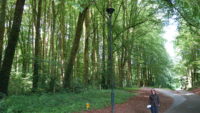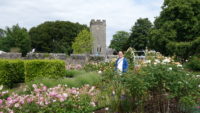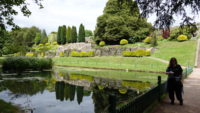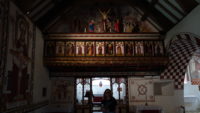 Meredith and I enjoy folk museums/villages, where old buildings (usually farmhouses) are preserved so visitors can see how people of yesteryear lived. We’ve been to such museums in Lithuania, Ireland, Scotland, Czechia, and the US. And so it was that we drove the twenty minutes west to St. Fagans National Museum of History, which is the Welsh version of a folk museum.
Meredith and I enjoy folk museums/villages, where old buildings (usually farmhouses) are preserved so visitors can see how people of yesteryear lived. We’ve been to such museums in Lithuania, Ireland, Scotland, Czechia, and the US. And so it was that we drove the twenty minutes west to St. Fagans National Museum of History, which is the Welsh version of a folk museum.
Often, folk museums tend to be dominated by a brutish living-under-thatch feeling, but St. Fagans surprised me right out of the gate. The first house we saw inside the museum was a two-story red farmhouse from the early 1600s. While it did have a thatched roof, it was unusual in my experience in that the inhabitants painted it red (such houses are usually whitewashed or left natural stone). Supposedly, the red was to keep evil spirts away. But when we were actually under the straw roof, the home was quite comfortable-looking, with multiple rooms and real floors (not dirt).
 That mostly set the tone for the day – being surprised at, in general, how comfortable the homes were. Some were as old as the late 1400s, but most were from the 1700s. By comparison, other folk museums we’ve visited had homes from this period that had dirt floors and, at most, two rooms. Mind you, when the guides mentioned how the parents, six children, and a lodger lived in the very small home, then you will understand I’m not ready to sell my own home. I thought most of the homes we saw today were small for two people, let alone six or eight or ten.
That mostly set the tone for the day – being surprised at, in general, how comfortable the homes were. Some were as old as the late 1400s, but most were from the 1700s. By comparison, other folk museums we’ve visited had homes from this period that had dirt floors and, at most, two rooms. Mind you, when the guides mentioned how the parents, six children, and a lodger lived in the very small home, then you will understand I’m not ready to sell my own home. I thought most of the homes we saw today were small for two people, let alone six or eight or ten.
The museum has about sixty different buildings, including a still-working farm and a manor house. The manor house was a summer home for the very wealthy earl who owned the docks of Cardiff during the coal heyday of 1900. His grandson donated the manor and grounds in 1946 to what would become the museum. The manor and grounds are still immaculately kept.
 Some of my favorite buildings from today:
Some of my favorite buildings from today:
– The one-room school house, of course. My life has been around schools for a long time.
– A church that was restored to how it would have looked before the Reformation. It’s the first church I have seen with bright colors and walls covered in biblical stories. It was very pretty.
– A row of townhouses, with individual house sections set up from different periods in the 1800s and 1900s, even up to the 1980s. I wasn’t too thrilled to see my teen years in a museum of folk history.
– A small farmhouse with box beds (which are beds in a box) that created small private spaces in an otherwise open room. The house was very small, but was furnished smartly.
 The museum also realized that most Welsh people from 1890 and on lived in cities, so they started adding early 1900s town buildings, including a hotel, a general store, and a social hall for coal miners. That seemed wise to me.
The museum also realized that most Welsh people from 1890 and on lived in cities, so they started adding early 1900s town buildings, including a hotel, a general store, and a social hall for coal miners. That seemed wise to me.
We mostly finished the day with the manor house and the grounds. The gardens were in bloom, and they were a joy to stroll. We swung by a few more buildings on the way out, including a highly mechanized weaver’s cottage from the late 1800s, but we had to skip the last few buildings we had missed. We got to the museum when the doors opened at 10:00 and closed the place out at 5:00. We needed another thirty minutes. Next time.
 We had supper at an inn right outside the museum, which was great in that it got us to about 6:15, so traffic had settled some as we drove back home. Mer has finished up her part of the touring for Wales, meaning that tomorrow through Monday is all my responsibility. I have big shoes to fill.
We had supper at an inn right outside the museum, which was great in that it got us to about 6:15, so traffic had settled some as we drove back home. Mer has finished up her part of the touring for Wales, meaning that tomorrow through Monday is all my responsibility. I have big shoes to fill.